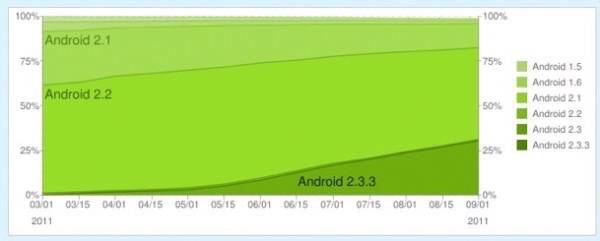

Last week, Google updated its statistics on Android version distribution. As Android evolves, one of its fragmentation issues will always be what build of the operating system people are actually using. As of Sept. 2, more than half of Android devices are still using version 2.2 (Froyo) but the recent update shows a significant gain for devices that have been updated to the latest version of the OS, Gingerbread.
Froyo is installed on 51.2% of devices. Yet, there are still a substantial amount of devices running an Android version below that. Cupcake, Donut and Éclair still make up 16.1% of all Android devices, with Éclair (version 2.1) on 13.3%. Honeycomb, Android’s tablet OS has 1.4% of the distribution between it three API levels.
Gingerbread is running on 31.3% of Android devices, which actually shows that the OEMs and carriers have started to push it out more in the last couple of months. Manufacturers like Samsung (which controls a significant amount of Android market share) have been notoriously slow in pushing out updates to all their devices across carriers. Samsung and other manufacturers blame the slow update process on the carriers, the carriers blame the manufacturers. An over-the-air update of several million devices is not an easy thing to coordinate. It is expensive mostly because it eats a lot of bandwidth.
In May, the carriers and OEMs supposedly came to an agreement to push out updates faster. Let us know in the comments if you think there has actually been a concerted effort to push out updates to more devices in a more timely fashion.
The data is compiled by Google based on the number of Android devices that accessed the Android Market over a 14-day period ending Sept. 2. That means there could be significant fluctuations in the amount the distribution of devices in the wild (ask yourself, when was the last time you visited the Android Market?). Yet, the sample size should be large enough for Google to fairly estimate the distribution.

Distribution numbers are important to app developers because not all versions handle bugs the same way. What might work perfectly in Froyo might be prone to crashing in Gingerbread (the TweetDeck app is a good example of this). Yet, developers must take a classic utilitarian approach of “what is best for the most amount of people.” If some versions of Android need to be neglected (Éclair and below) for the rest to work, that is just the sacrifice that developers have to make.
Yet, the product pipeline and Android sales numbers are accelerating. Most new phones are shipping with Gingerbread while only second-market devices are still shipping with Éclair or below.

















